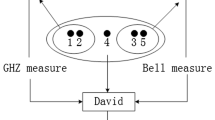Abstract
A novel quantum group proxy blind signature scheme based on five-qubit entangled state is proposed. The quantum key distribution, quantum encryption algorithm and some laws of quantum mechanics (such as quantum no-cloning theorem and Heisenberg uncertainty principle) are used to guarantee the unconditional security of this scheme. Analysis result shows that the signature can neither be forged nor disavowed by any malicious attackers and our scheme satisfies all the characteristics of group signature and proxy signature. This protocol can be applied in real life such as E-commerce transaction.

Similar content being viewed by others
References
Shor, P.: Polynomial-time algorithms for prime factorization and discrete logarithms on a quantum computer. SIAM J. Comput. 26(5), 1484–1509 (1997)
Grover, L.K.: A fast quantum mechanical algorithm for database search (1996)
Bennett, C.H., Brassard, G.: Quantum cryptography: Public key distribution and coin tossing. In: Proceedings of the IEEE International Conference on Computers. Systems and Signal Processing, Bangalore, India, pp. 175–179. IEEE, New York (1984)
Bennett, C.: Quantum cryptography using any two nonorthogonal states. Phys. Rev. Lett. 68, 3121–3124 (1992)
Salas, P.: Security of plug-and-play QKD arrangements with finite resources. Quantum Inf. Comput. 13, 861–869 (2013)
Xiao, L., Long, G.L., Deng, F.G., et al.: Efficient multiparty quantum secret sharing schemes. Phy. Rev. A 69, 052307 (2004)
Tsai, C., Hwang, T.: Multi-party quantum secret sharing based on two special entangled states. Sci. China Phys. Mech. Astron. 55(3), 460–464 (2012)
Massoud, H., Elham, F.: A novel and efficient multiparty quantum secret sharing scheme using entangled states. Sci. China Phys. Mech. Astron. 55(10), 1828–1831 (2012)
Adhikari, S., Chakrabarty, I., Agrawal, P.: Probabilistic secret sharing theory through noisy channel. Quantum Inf. Comput. 12, 253–270 (2012)
Qin, S.J., Gao, F., Wen, Q.Y., et al.: Improving the security of multiparty quantum secret sharing against an attack with a fake signal. Phys. Lett. A 357, 101–103 (2006)
Wang, T.Y., Liu, Y.Z., Wei, C.Y., et al.: Security of a kind of quantum secret sharing with entangled states. Sci. Rep., 7(1) (2017)
Wang, T.Y., Li, Y.P.: Cryptanalysis of dynamic quantum secret sharing. Quantum Inf. Process. 12(5), 1991–1997 (2013)
Bostrom, K., Felbinger, T.: Deterministic secure direct communication using entanglement. Phy. Rev. Lett. 89, 187902 (2002)
Deng, F.G., Long, G.L., Liu, X.S.: Two-step quantum direct communication protocol using the Einstein-Podolsky-Rosen pairblock. Phys. Rev. A 68, 042317 (2003)
Huang, W., Wen, Q.Y., Jia, H.Y., et al.: Fault tolerant quantum secret direct communication with quantum encryption against collective noise. Chin. Phys. B 10, 100308 (2012)
Wang, T.Y., Ma, J.F., Cai, X.Q.: The postprocessing of quantum digital signatures. Quantum Inf. Process. 16(1), 19 (2017)
Wang, T.Y., Wei, Z.L.: Analysis of forgery attack on one-time proxy signature and the improvement. Int. J. Thero. Phys. 55(2), 743–745 (2016)
Wang, T.Y., Cai, X.Q., Zhang, R.L.: Security of a sessional blind signature based on quantum cryptograph. Quantum Inf. Process. 13(8), 1677–1685 (2014)
Wang, T.Y., Wei, Z.L.: One-time proxy signature based on quantum cryptography[J]. Quantum Inf. Process. 11(2), 455–463 (2012)
Gottesman, D., Chuang, I.: Quantum digital signature. arXiv:0105032v2 (2001)
Zeng, G.H., Keitel, C.H.: Arbitrated quantum-signature scheme. Phys. Rev. A 65, 042312 (2002)
Yang, Y.G.: Multi-proxy quantum group signature scheme with threshold shared verification. Chin. Phys. B 17, 415 (2008)
Yang, Y.G., Wen, Q.Y.: Threshold proxy quantum signature scheme with threshold shared verification. Sci. Chin. Ser. G: Phys. Mech. Astron. 51(8), 1079–1088 (2008)
Yang, Y.G., Wang, Y., Teng, Y.W.: Scalable arbitrated quantum signature of classical messages with multi-signers. Commun. Theor. Phys. 54, 84 (2010)
Tian, J.H., Zhang, J.Z., Li, Y.P.: A quantum multi-proxy blind signature scheme based on genuine four-qubit entangled state. Int. J. Thero. Phys. 55(2), 809–816 (2016)
Guo, W., Zhang, J.Z., Li, Y.P., et al.: Multi-proxy strong blind quantum signature scheme. Int. J. Thero. Phys. 55(8), 3524–3536 (2016)
Chaum, D., Van, H.E.: Group Signature. Advances in Cryptology, pp. 257–165. Springer, Berlin (1991)
Wen, X., Tian, Y., Ji, L., et al.: A group signature scheme based on quantum teleportation. Phys. Rev. A 81(5), 055001 (2010)
Xu, R., Huang, L., Yang, W., et al.: Quantum group blind signature scheme without entanglement. Opt. Commun. 284, 3654–3658 (2011)
Zhang, K.J., Sun, Y., Song, T.T., et al.: Cryptanalysis of the quantum group signature protocols. Physics 52(11), 4163–4173 (2013)
Su, Q., Li, W.M.: Improved group signature scheme based on quantum teleportation. Physics 53(4), 1208–1216 (2013)
Zhang, K., Song, T., Zou, H., et al.: A secure quantum group signature scheme based on Bell states. Phys. Scr. 87(4), 045012 (2013)
Khodambashi, S., Zakerolhosseini, A.: A sessional blind signature based on quantum cryptography. Quantum Inf. Process. 13(1), 121–130 (2014)
Xiao, M., Li, Z.: Quantum broadcasting multiple blind signature with constant size. Quantum Inf. Process. 15(9), 1–14 (2016)
Shi, W.M., Zhang, J.B., Zhou, Y.H., et al.: A new quantum blind signature with unlinkability. Quantum Inf. Process. 14(8), 3019–3030 (2015)
Brown, I., Stepney, S., Sudbery, A.: Searching for highly entangled multi-qubit states. J. Phys. A: Math. General. 38, 1119–1131 (2005)
Ekert, A.K.: Quantum cryptography based on bell theorem. Phys. Rev. Lett. 67, 661–663 (1991)
Acknowledgements
This work is partially supported by the National Key R&D Program of China (Grant No. 2017YFB0802400), the National Science Foundation of China (Grant No. 61373171,61702007), the 111 Project under (Grant No. B08038)
Author information
Authors and Affiliations
Corresponding author
Additional information
Publisher’s Note
Springer Nature remains neutral with regard to jurisdictional claims in published maps and institutional affiliations.
Rights and permissions
About this article
Cite this article
Liu, G., Ma, WP., Cao, H. et al. A Novel Quantum Group Proxy Blind Signature Scheme Based on Five-Qubit Entangled State. Int J Theor Phys 58, 1999–2008 (2019). https://doi.org/10.1007/s10773-019-04093-9
Received:
Accepted:
Published:
Issue Date:
DOI: https://doi.org/10.1007/s10773-019-04093-9




